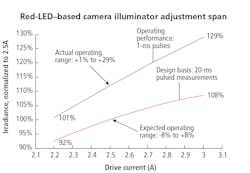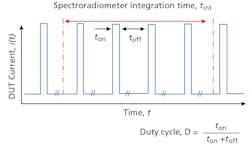Until recently, 20-ms current pulses have been considered the standard for determining the electrical and optical parameters provided in LED device data sheets and to test and assign an LED to a product bin. Several industry trends have now exposed the limitations of 20-ms long-pulse measurements, which will be discussed here along with the industry’s first response: improved short-pulse measurement methods, documented in new standards from the Illuminating Engineering Society (IES) and CIE (Commission Internationale de l´Eclairage — the International Commission on Illumination). A future article will present the industry’s second response: improved third-generation spectrometers and source/measure instruments that simplify testing with the new methods.
Introduction to pulse measurements
For decades, researchers and manufacturers used the 20-ms measurement pulse to characterize and bin LEDs. (Learn more about LED binning methodology.) The duration fit early LEDs nicely — fast enough to limit junction heating, but long enough to provide enough light to measure.
However, LEDs in 2022 are different from LEDs in the 2000s. They have smaller internal structures, operate at higher current densities, and are more likely to be driven with pulsed current that exceeds the nominal direct current (DC). During testing, the LED junction heats quickly, and its output begins to droop long before a 20-ms pulse ends. Still, many laboratories are using this long pulse to characterize their LEDs. The resulting data — in the form of I-V (current versus voltage), L-I (light versus current), and peak wavelength curves — often exhibits significant errors at high current levels. The 20-ms pulse may be the industry standard today, but change is coming.
Package and applications trends prompt change
Three trends in particular are forcing manufacturers to rethink their test methods: LEDs with highly optimized heat structures in their packages, high-luminance applications, and pulse-width modulation (PWM) applications.
To reduce costs, many LEDs now utilize package designs that eliminate the internal heat spreading elements present in previous-generation LEDs. The heat spreaders acted as reservoirs during testing, slowing the rise in the LED’s junction temperature. Optimized LEDs with slimmer packages heat quickly during a single long-pulse measurement and, when a measurement sweep is made, the cumulative heating from multiple measurements can result in heating-induced output droop and wavelength shift — both of which can mask the LED’s true characteristic.
High-luminance applications are also prompting novel approaches. Overhead lighting, the big market for early LEDs, used large-area LEDs to operate efficiently at a low current density (less than 1A/mm2). Today’s high-luminance applications, such as machine vision, video projection, and specialty and automobile lighting, favor a point-source emitter to simplify optics design. Thus, LEDs in these applications have only a small emitting area. To produce the required luminance, they operate at current densities well above 1A/mm2.
At these high current densities, electrical conversion efficiency is significantly lower. This, along with the small light-emitting area, results in a high power-per-area figure. Even though high-luminance LEDs typically have significant heat-handling structures, the high power-per-area means they also experience rapid junction heating during testing. As with optimized LEDs, when high-luminance LEDs are tested with long-pulse techniques, junction temperatures can shift by dozens of degrees, greatly distorting the resulting performance curves.
LEDs are increasingly being used in a pulsed operation mode, often utilizing PWM at 120-Hz or 240-Hz video rates for applications such as machine vision and projection display. Many of these applications involve inherently wasteful low-duty-cycle operation in which the LED component is operating less than half of the time. Solid-state lighting (SSL) product developers gain back some of the lost efficiency by driving the LED at currents greater than the recommended DC voltage.
Because 20-ms pulse testing generates so much heat, LED manufacturers historically restrict the data sheet curves to the recommended DC device current and limit the available performance-versus-temperature data — sometimes only a single temperature value is provided for key characteristics, such as peak wavelength. Without high-current-density data, lighting designers are forced to extrapolate using low-current-density data and then confirm those extrapolations in the lighting product’s final test — a risky approach that can result in expensive delays and redesigns if extrapolations are inaccurate.
Even if high-current-density data was provided by manufacturers, it may be misleading if it was collected using long-pulse methods. An example application (Fig. 1) illustrates why. A red LED is driven with 1-ms pulses at a 60-Hz frame rate to provide illumination for a machine vision camera. Based upon 20-ms measurement data, the required nominal irradiance can be met with a drive current of 2.5A, and an adjustment span of ±8% can be realized by varying the drive current from 2.2A to 3A.
However, if the illuminator is designed with these values, the intended 92% to 108% span is unobtainable when the illuminator is operated with 1-ms pulses. The 2.2A to 3A drive always produces more light than needed, ranging from 101% to 129% of the required irradiance. This excess illumination can degrade the contrast of the captured images enough to jeopardize the recognition algorithm. At the minimum, the illuminator design wastes energy and is more costly than necessary.
Metrologists are shifting to short-pulse measurements
To combat heating, LED metrologists have begun shifting to shorter measurement pulses.1 For some devices, Nichia uses Continuous Pulse (CP), a method it pioneered that utilizes pulses in the 50-µs range. Ams Osram is shifting some testing to pulses on the order of 1 ms, in its Flash Pulse (FP) method. With pulses this short, the spectrometer used to collect the LED’s light must start integrating before the pulse begins and it must continue after the pulse ends.
However, including the light produced during the current pulse rise and fall in the measurement introduces a new set of errors. In some instances, these rise/fall errors can exceed the original heating error. Metrologists at both companies have developed improvements to the CP and FP short-pulse methods that reduce these errors. At the U.S. National Institute of Standards and Technology, optical engineer Yuqin Zong adopted and further refined Nichia’s improved CP method, increasing its accuracy. NIST now uses it to create its UV-LED primary measurement standards.2,3
Upcoming standards feature new measurement methods
The IES and CIE standards organizations are incorporating improved short-pulse methods into standards under development.4,5 For existing standards, like the IES Approved Method: Optical and Electrical Measurements of LED Sources (LM-85), the improved methods are being added to the document’s existing palette of allowed methods. Tellingly, the IES’s newest standard, Approved Method: Optical and Electrical Measurement of Ultraviolet LEDs, released this year, is limited to short-pulse methods for most situations. This was done to guarantee only a small temperature rise during testing and to circumvent the transient-voltage effect, a measurement issue that some UV LEDs present. The good news for LED manufacturers and lighting designers is the committees that wrote the standards explain the improved methods in detail and provide helpful illustrations.
The right time to switch
As the LED industry advances, the heating-induced errors associated with 20-ms testing can no longer be ignored, especially for pulsed LED designs and high-luminance applications. Fortunately, better test methods, documented in new standards, are enabling a shift to short-pulse methods that reduce heating. The resulting enhanced data can enable SSL-product developers to create more efficient and cost-effective UV and visible-light products.
SSL product developers can utilize the new methods today when they test candidate LEDs. They can also influence manufacturers to adopt short-pulse test methods by insisting on more accurate LED datasheet and binning data.
In an upcoming LEDs Magazine issue, a follow-on article will explore the new test method’s impact on the tools used to make electro-optical measurements: the spectrometer and the source/measure instrument. Like the IES and CIE standards, these instruments have evolved to meet the performance demands posed by modern LEDs. New third-generation instruments now allow labs to perform short-pulse tests with pulses as short as a few microseconds and with greater accuracy.
REFERENCES
1. J. Hulett and M. Schneider, “Short-Pulse Testing Eliminates Self-Heating Errors to Produce True L-I Graphs,” LED Professional Review, 83, 72–77 (Jan/Feb 2021).
2. Y. Zong, “Accurate measurement of ultraviolet light-emitting diodes,” CIE 2021, Sept. 27–29, 2021.
3. Y. Zong et al., “Mean Differential Continuous Pulse Method for Accurate Optical Measurements of Light Emitting Diodes and Laser Diodes,” J Res, NIST, 126 (November 2021).
4. Illuminating Engineering Society.
5. International Commission on Illumination.
Get to know our expert
JEFF HULETT is CTO and founder of test & measurement specialist firm Vektrex, based in San Diego, CA. Over the course of his career, Hulett has acted as chief engineer on products ranging from single-board computers for spaceflight to power supplies for DNA sequencing systems to current sources used in the LED and laser industries for product and system evaluation. Hulett holds several patents related to LED testing and has authored technical articles for publications such as LEDs Magazine and Photonics Spectra. He also serves as chair of the Illuminating Engineering Society’s LM-80 Working Group.
Vektrex supplies test & measurement equipment such as source/measure units and current sources that support evaluation methods described in this article.
An abridged version of this article was published in the April/May 2022 issue of LEDs Magazine.
For up-to-the-minute LED and SSL updates, why not follow us on Twitter? You’ll find curated content and commentary, as well as information on industry events, webcasts, and surveys on our LinkedIn Company Page and Facebook page.







